Static Grass Applicator

(Please forgive the layout of this post, I have a hell of a time with this site getting images to simply align in the order I want. It may be a Firefox thing. You can find a more organized post here on my site).
I've been playing with scenery, and wanted to move my testing onto the static grass. The applicators seem the way to go, but I'd rather spend $200 with one of the advertisers here before buying a Noch version.
Thanks to this website that had a great break down of items to purchase, I got the parts, and started whipping my homemade version into shape.
The key, it seems, is the negative ion generator. I know some folks have had luck with a electronic fly swatter, but in the middle of winter they're kind of hard to find, so I went ahead and ordered one of these. As an added bonus, it is 12 volt.
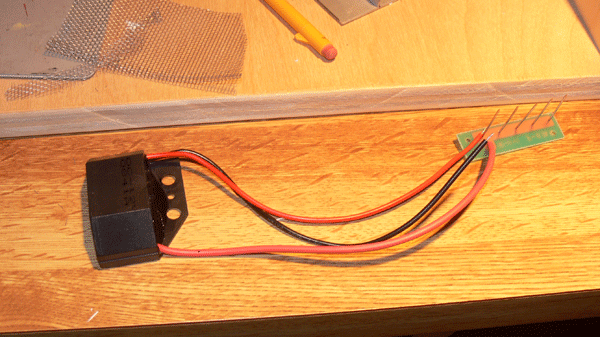
First up was a rough approximation of the tutorial.
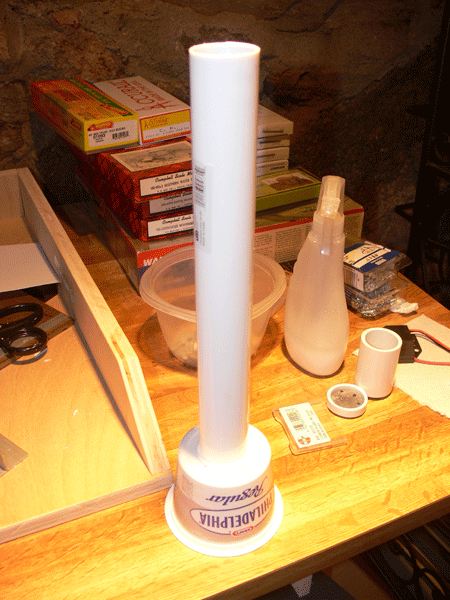
I realized after beginning construction that the shape isn't relevant to the function (or at least I believe). What is important is that the wiring is sound. The package is in some degree not material as long as the grass passes through the screen that is receiving the charge.
Based on that, and that I was having a hard time getting the two parts above to adhere, I went with a simpler model. It is smoked almond container, with the screen not glued in, but just pinned by the cap and the top of the jar. I liked the thicker plastic, and duct tape seemed to hold the electonics pretty securely.
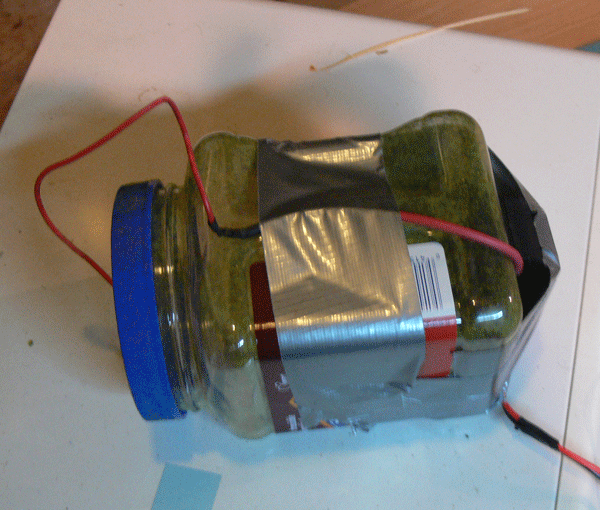
This ion generator is from the automotive world, and is 12 volt, which is the same voltage i realized as my MRC 12 volt powerpack. I have that powerpack on a toggle switch so I can go between DC and DCC on my layout; I figured why bother with another power source? The Red and Black alligator clips attach to any rail section, the green is for the ground. I just clip them on and fire up the powerpack to 80/90%.
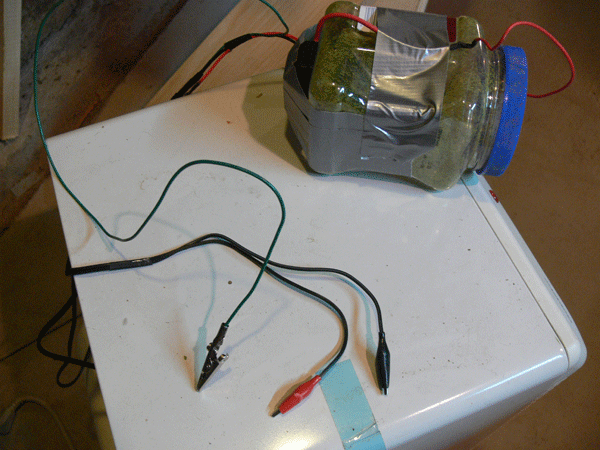
My question for this educated audience is the results. I am 98% sure the wiring is right as it makes a noise, and static electricity increases as the mesh gets close to the ground, but does the end result look right? As I haven't seen any in person, I'd like you to evaluate the before and after, just to confirm if I'm on the right track, or if I need to return to the drawing board. At the end, please find a before and after picture of the test area.

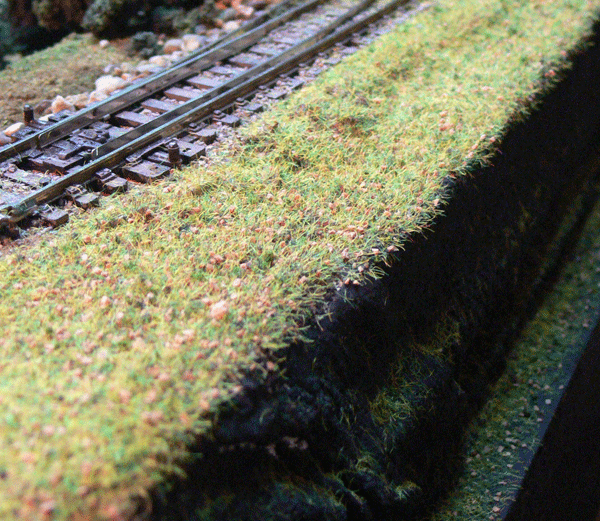
>> Posts index
Navigation
Journals/Blogs
Recent Blog posts:
ION's off-line
Scarpia said:
"I am planning on doing just that - putting the ion generator off tool."
Hey that's a great idea! That's thinking outside the box. Not only would that allow one to use the retail containers as an applicator but in the case of those who still build an applicator it may be handy to have a large applicator for open areas and a smaller applicator for tight spots. If the electronics are off-tool it would just be a matter of plugging in the applicator best suited to the job. Thanks for the insight and ideas. Looking forward to further installments!
I'd be interrested to know
I'd be interrested to know precisely what the polarization on a negative ion generator is. Electricty flow is + to -; it doesn't get much more complicated.
In these applications it seems we are simply inducing a charge onto uncharged particles; once charged, the particles repel the pole they touched.
I got curious about what these things are: here's my results:
http://www.eskimo.com/~billb/emotor/negion.html
Now things may sense!!
[but there's a new source for the device...]
---------------------------------------------------------------------------------------------------------
Benny's Index or Somewhere Chasing Rabbits
Just keep in mind...
The negative ION generator used in the static applicator is 12 volt DC not 120 volt AC. I guess they are used in air filtration systems to remove dust & pollen I think.
Electronic Goldmine is the source I have seen referenced before. The generator is also available from model-trains-video.com I believe.
Well, yes, but some people
Well, yes, but some people have been complaining about the voltage being too low...you thing 10,000V at the business end will satisfy them?
Apparently at a microamp or so that is safe - I remember that from electricity class - it's the Amps[current] that will kill you.
If these were used in Air filtration systems as that page says, that provides a cheap yardsale source for negative ion generators...he found his for $5 bucks apparently.
---------------------------------------------------------------------------------------------------------
Benny's Index or Somewhere Chasing Rabbits
Volts and amps...
I was not aware people were complaining they needed more power. Too many Tim the Tool Men out there I guess. ;o)
Benny said:
"I remember that from electricity class - it's the Amps[current] that will kill you."
Yes and IIRC I was told in that class that if the conditions are perfect it only takes about .8 of an amp to do the job. Less if the current is applied directly to the heart but who would be that stupid?
Red Green meets Tim the
Red Green meets Tim the Toolman Taylor...oh dear...
I once read a column in an OLD MR by an author guy who visited strange layouts. In his travels he came across one man who had roughy F scale trains or perhaps bigger; this guy used Blender motors to power his engines - and guess what the track voltage was!! Household 220V on the rails!!
But the trains ran really REALLY well...
Apparently the generators in the air cleaners is low enough to be safe...but don't take MY word on that!!
---------------------------------------------------------------------------------------------------------
Benny's Index or Somewhere Chasing Rabbits
some electricity basics
"Electricty flow is + to -; it doesn't get much more complicated."
No, it isn't. "Conventional flow" was debunked a century ago. Simply put, "electron flow" (excess charge) is from - to +. Voltage is the electromotive force (EMF, potential difference) between two poles. Current is the rate of flow of a given number of charged particles passing through a conductor at a given point (1 Amp = 6.25x10^18 electrons/sec). The full details are not particularly relevant to basic modelling.
High voltage and low current should not be taken lightly; witness the recent spate of Taser-related injuries from units out of calibration or mis-applied by law enforcement officers. An unexpected "static" shock can also result in unintended movements of the hand or arm which may put them in harm's way.
As an aside, decoders with a "Back EMF" feature compensate for the inductive counter force that a motor generates during rotation, varying with RPM. It effectively smooths changes in the motor's rotation by addressing load variation.
As another aside, Back EMF is what affects DC solenoid (relay) coil circuits; hence the inclusion of a properly oriented diode across the coil terminals to short-circuit the reverse voltage spike generated as the magnetic field of the coil collapses when the power to the relay is shut off.
Visit the S Scale Workshop blog
Hard to see the point
I have a hard time seeing the point in modifying a room air cleaner unless you could get it for less than $5. The 12 volt version I got for $15 delivered from electronics goldmine; the work involved in ripping apart and re-rigging a home air cleaner version, seems kind of not worth it. Once you have bought the ion generator, the rest of the materials can be either "found" or sub $1 (alligator clips, wire, screen, and electricians tape).
I decided not to move the generator off the tool at this time as I did such a nice job soldering it up. Instead I'm going to use a velcro strap to attach it on a per use basis to the side of the flock container. I cut a piece of screen to fit the 32 ounce bottles last night; as soon as I receive my scenic express order I'll give it a whirl and post up the results.
Me and battery poles never
Me and battery poles never quite get it right - I need a battery diagram to remember it right - but yes, I remember now - it's the electorns that are moving! Now the real challenge is when you get to the wires and remembering which is red and which is black and WHY!! In accounting Black Ink is the one you have in excess, but in a battery you have excess negative - and that's a good thing! So black is the Negative terminal! But then You'll run into places where the person was thinking in the conventional manner; black is positive, red is negative!
Of course all what really matters is that the Negative lead is at the top of the hill, so to speak, and the positive lead is at the end bottom of the hill. Getting those two switched and you either blow the circuit or nothing happens because someone smart put a couple diodes in the circuit!
If the leads are exposed on the first tool, then you can hook a second tool up to the first tool with no issues...I think that's what you were saying though; all you need is a double ended set of wires with alligator clamps to go from tool one to tool two, kind of like jumper cables.
---------------------------------------------------------------------------------------------------------
Benny's Index or Somewhere Chasing Rabbits
Accounting and battery poles
<Me and battery poles never quite get it right - I need a battery diagram to remember it right - but yes, I remember now - it's the electorns that are moving! Now the real challenge is when you get to the wires and remembering which is red and which is black and WHY!! In accounting Black Ink is the one you have in excess, but in a battery you have excess negative - and that's a good thing! So black is the Negative terminal! But then You'll run into places where the person was thinking in the conventional manner; black is positive, red is negative!>
Don't confuse polarity with accounting and the color of the ink used.
The coilor of the ink used has nothing to do with excess that are positive or negative. Red ink was used in the days before printing of financial statements became common to show that the company had a negative income (expenses greater than revenue). Today this shown in parenthesis.
Polarity is a different issue entirely.
Irv